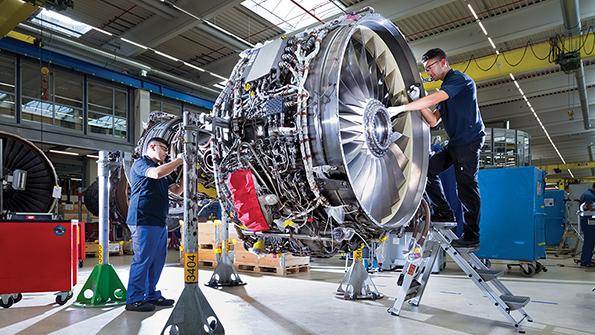MRO市場におけるナローボディー機の新旧駆動エンジン

CFM56ファミリーとV2500ファミリーは、2020年、MRO需要を強化すると共に、商用エンジンにおけるアフターマーケットの支出で約三分の一を占めます。後続モデルの運用開始が遅れているため、成熟したモデルの運用が長く維持されているからです。
ここ数年間の減速は、CFM International’s LeapとCFM56の後続エンジン、Pratt & Whitney社の PW1000G型のギヤードターボファン(GTF)に関連する技術的な問題の結果です。『アビエーションウィーク』誌の最新Fleet & MRO Forecastが年間347億ドルを予想する商用エンジン部門において、CFM56とV2500は、12か月の共同出費で129億ドルを生み出すと予想します。
今年、CFM56ファミリーが23,058基ほどの運用を、最も突出したBoeing 737NG機に搭載するCFM56-7B派生型の運用と共に計画されています。同機はCFM56を搭載した航空機の半分以上を占めています。一方、V2500エンジンは、Airbus A320ファミリーに搭載され、6,000基が運用中です。
運用の余剰は修理の専門家にとって朗報です。しかし、CFM56とV2500の寿命が長いことは、少なくとも次の2~3年の間、MRO市場のキャパシティにとってタイトな状況が続きます。さらに、スペアエンジンおよび関連材料の在庫は、退役という形で市場に出回り、多くの補給品を供給するようになってから数年の間に不足するでしょう。
このような退役は、2023年にCFM56エンジンから始まると予想されます。その時に、1,000基以上のエンジンが初めて退役します。今から10年後の2029年までに、8,858基ほどのCFM56エンジンが運用を終えるでしょう。さらに、V2500の退役が増加しつつあります。2020年にちょうど98基が退役し、10年の間に約2,178基のV2500が廃棄される予定です。
新たなナローボディ機用エンジンの登場が遅れていました。まだそれにもかかわらず、LeapとGTFの登場が好転させると予想します。『アビエーションウィーク』誌のデータによると、2020年、Leapエンジンは約2,600基の納入が見込まれています。しかし、この数はCFM56-1B派生型、すなわちBoeing 737 MAX型プログラムの新型エンジン基数に基づいたものです。
2019年、Leapエンジンと関連性のない問題が同機につきまとい、3月の飛行禁止につながりました。Boeing社は、同機を2020年中に運航再開させる予定だと発表しました。しかし、この飛行禁止がOEMにいくらかの打撃を与えてきました。
それ以来、(British Airwaysが200機受注したように)MAX型の大型受注を続ける航空会社もありましたが、受注を見送る航空会社もありました。その中に、サウジアラビアの格安航空会社Flyadealもあります。同社は、2019年夏、Leapを搭載した航空機の受注を最大50機キャンセルしました。2015年に運用を開始したA320ネオ搭載のLeap 1A派生型は、2024年までに、重要なMRO支出を何ももたらさないでしょう。
『アビエーションウィーク』誌の予想によると、ワイドボディ機のエンジンセグメントは、2020年、市場で165億ドルを占めます。GE Aviation社とRolls-Royce社が占める同セグメントは市場でそれぞれ50%と33%を占め、同年を通じておよそ2,257件の整備件数を占めるでしょう。GE Aviationの市場占有率のうち30%が、CF6-80C2から生み出され、A330と747、767といったBoeing社とAirbus社のワイドボディ航空機に搭載されています。
燃料消費の削減を求める航空会社に人気の787型航空機に搭載されたことから、GE Aviation社は2020年にGEnxエンジンを248基配備することで、最高納入数を示します。『アビエーションウィーク』誌によるデータによると、これは、A350にのみ使用されるRolls-Royce社のレントXWBに続き、2020年に240基の納入を見込みます。A330と757、767などの航空機に搭載したGE社製のCF6-80モデルは、2020年から2029年の間に、1649基を数え、この10年で最高の退役数になるでしょう。
世界の商用機の5%を占めるターボプロップセグメントにおいて、アフターマーケットに関する支出の中心は、ほんの一握りのエンジンタイプが占めています。Pratt & Whitney Canadaは2020年、同市場の80%以上を占めています。そのほとんどが、もともとATR42とATR72に搭載されていたPW1000エンジンに関連しています。ターボプロップセグメントに新規参入の見込みはありませんが、OEM市場実績は、その後の10年間で伸びるでしょう—2029年までに約92%になります。
Aviation Week Networkの2020 Fleet & MRO Forecastsをもっと知りたい場合、こちらをクリックして下さい。
The CFM56 and V2500 families will account for around one-third of commercial engine aftermarket spending in 2020, with MRO demand boosted as mature models are kept in service longer owing to the slower pace of their successors entering service.
This slowdown is the result of technical issues related to CFM International’s Leap, the CFM56’s successor, and the Pratt & Whitney PW1000G geared turbofan (GTF) over the past few years. In a commercial engine segment valued at $34.7 billion for the year by Aviation Week’s latest Fleet & MRO Forecast, the CFM56 and V2500 are forecast to generate $12.9 billion in combined spending over a 12-month period.
The CFM56 family is projected to have approximately 23,058 units in service this year, with the -7B variant powering the Boeing 737NG the most prominent, accounting for more than half of the CFM56 fleet. Meanwhile, the V2500 engine found on the Airbus A320 aircraft family will have 6,000 units in service.
While the surplus of work will be good news for repair specialists, the longevity of the CFM56 and V2500 also could ensure that MRO market capacity will remain tight for the next 2-3 years at least. The availability of spare engines and related materials likely also will be scarce for the next few years, until relief comes in the form of retirements hitting the market and supplying more used materials.
These retirements are expected to pick up starting in 2023 for CFM56 engines, when for the first time more than 1,000 will be retired during that year. By the end of the decade in 2029, an estimated 8,858 CFM56 engines will leave service. Retirements of the V2500 also will increase gradually. Numbering just 98 in 2020, over a 10-year period approximately 2,178 V2500s will be phased out.
While the arrival of the new narrowbody engines has been sluggish, the influx of the Leap and GTF is nevertheless still expected to pick up. According to Aviation Week data, around 2,600 deliveries of the Leap are expected in 2020. However, this figure could be dependent on the fortunes of the -1B variant, the engine option for the Boeing 737 MAX program.
In 2019, the aircraft was dogged by problems unrelated to its Leap engines, leading to the grounding of the fleet in March. Boeing said it intends to have the aircraft back in service during 2020, but the groundings have hit some OEMs hard.
While some airlines have since placed large orders for the MAX (such as British Airways’ for 200 aircraft), others have chosen to look elsewhere. These include low-cost carrier Flyadeal of Saudi Arabia, which canceled its order for up to 50 of the Leap-powered aircraft in summer 2019. The Leap 1A variant for the A320neo, which entered service in 2015, will not see any significant MRO spending until 2024.
Aviation Week predicts the widebody engine segment will account for $16.5 billion of the market in 2020. The segment, dominated by GE Aviation and Rolls-Royce, which hold 50% and 33% shares of the market, respectively, will account for an estimated 2,257 maintenance events throughout the year. Of GE Aviation’s market share, 30% will emanate from the CF6-80C2, used on several Boeing and Airbus widebody aircraft including the A330, 747 and 767.
Powering the 787, a popular aircraft option for airlines looking to reduce fuel consumption costs, GE Aviation’s GEnx engine will see the highest delivery volumes, with 248 engines set for 2020. This will be followed by Rolls-Royce’s Trent XWB, the exclusive option for the A350, which will see 240 deliveries in 2020, according to Aviation Week data. GE’s CF6-80 model, powering aircraft including the A330, 757 and 767, will have the highest volume of retirements over 10 years, numbering 1,649 units in 2020-29.
In the turboprop segment, which accounts for just 5% of the global commercial fleet, aftermarket spending is centered on just a handful of engine types. Pratt & Whitney Canada will hold more than 80% of the market in 2020, with much of this related to the PW100 engine, primarily found on the ATR42 and 72. With no new entrants expected in the turboprop segment, the OEM’s market dominance will grow over the next decade—standing at around 92% by 2029.
Click here to learn more about Aviation Week Network's 2020 Fleet & MRO Forecasts.